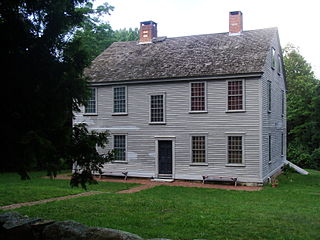
The General Nathanael Greene Homestead, also known as Spell Hall, is a historic house at 20 Taft Street in Coventry, Rhode Island. It was the home of American Revolutionary War general Nathanael Greene from 1770 to 1776, and was owned afterwards by his brother Jacob Greene and his wife Margaret. The house is owned and operated by the General Nathanael Greene Homestead Association, a non-profit organization, and was opened as a museum in 1924.

Warwick Light, also known as Warwick Lighthouse, is an historic lighthouse in Warwick, Rhode Island.

The Ballou House is an historic house on Albion Road in Lincoln, Rhode Island. It is a 2-1/2 story wood frame structure, five bays wide, with a large central chimney. A single-story gable-roof wing extends to the east, and a 20th-century gambrel-roofed ell extends to the north. The house was probably built c. 1782 by Moses Ballou, from one of the first families to settle in the area, and was owned by his descendants through most of the 19th century.

The Benjamin F. Greene House is an historic house at 85 Cross Street in Central Falls, Rhode Island, USA. The Second Empire house was designed by Clifton A. Hall and built by Wheeler & Marchant in 1868. The house is one of a small number of high-style mid-19th century houses in the city. It was built for Benjamin Franklin Greene, a second-generation mill owner in the Central Falls/Pawtucket area.
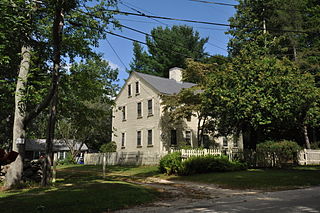
The Isaac Bowen House is an historic house in Coventry, Rhode Island. The 2-1/2 story center-chimney wood frame house, built c. 1750, stands on Maple Valley Road, near its junction with Rhode Island Route 102. The property, more than 3 acres (1.2 ha) extending to the road junction, is adjacent to the Audubon Society's George B. Parker Woodland Sanctuary, and is also owned by the society. The house was built by Isaac Bowen, a member of the locally prominent Bowen family, and is the only Bowen house to survive from that time. The house now serves as home to the Parker Sanctuary's caretaker.

Budlong Farm is an historic farmhouse at 595 Buttonwoods Avenue in Warwick, Rhode Island. It is a 1-1/2 story wood frame house, with a gambrel roof and a large central chimney. Its current entrance is asymmetrically placed on the north facade, although the original main entry was on the south side. The house was probably built sometime between 1700 and 1720 by John Budlong, whose family was one of the first to settle the area after King Philip's War. The property is a rare local example of architecture to survive from that period.

The Cowesett Pound is an historic animal pound on Cowesett Road in Warwick, Rhode Island. The pound, a roughly square structure built of unmortarted fieldstone four to five feet in height, is estimated to have been built in 1742 by David Greene, although there was an older pound already at the site. Its walls were probably once topped by capstones, but only one of these survives. The entrance to the pound has a wooden gate added during a 20th-century restoration.

Forge Farm is an historic farm at 40 Forge Road in Warwick, Rhode Island. Established in the mid-17th century by the Greene family, it is one of the oldest farms in Rhode Island. It was the birthplace of General Nathanael Greene, a prominent American general in the American Revolutionary War. The core of the main house was built in 1684 by James Greene, son of John Greene, who purchased the land from local Native Americans. It has been extended and altered numerous times in the 18th and 19th centuries. Nathanael Greene was born in this house in 1742, and the farm was owned for many years by Nathanael's brother Christopher, and wife, Deborah (Ward) Greene, daughter of Continental Congress member Samuel Ward.

The Forge Road Historic District is a historic district on Forge Road from Ives Road to the Potowomut River in Warwick, Rhode Island. Most of the district's nearly 200 acres (81 ha) are taken up by the Forge Farm, which lies south of Forge Road, is one of the oldest farms in Rhode Island, and was the birthplace of American Revolutionary War general Nathanael Greene. A memorial to Greene stands near the bridge crossing the Potowomut River. Opposite the farm on Forge Road stand four houses, all of which date to the late 18th to mid-19th century.

Captain Oliver Gardiner House is an historic house prominently located at 4451 Post Road in Warwick, Rhode Island. Built about 1750, it is a 2-1/2 story wood frame structure with a gambrel roof. Its main facade has six irregularly-spaced bays, with a centrally positioned entrance. The house is unusual for its period in that it has a large central hallway, a feature not commonly seen until the Federal period. Oliver Gardiner, its first owner, was a ship's captain.
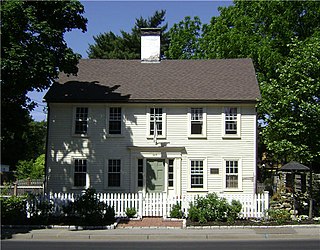
The Caleb Gorton House is an historic 18th-century house located in Warwick, Rhode Island.

The Caleb Greene House is an historic house at 15 Centerville Road in Warwick, Rhode Island.

The Peter Greene House is a historic house at 1124 West Shore Road in Warwick, Rhode Island. The 2-1/2 story wood frame house was built c. 1751, and is a rare surviving 18th-century house in Warwick. It has a five-bay facade with a plain door surround, a central chimney, and a rear ell.

The Richard Wickes Greene House is an historic house at 27 Homestead Avenue in Warwick, Rhode Island. The 2-1/2 story wood frame house was built in 1849, and is an excellent local example of transitional Federal-Greek Revival styling. Richard Wickes Greene was a ship's captain who acquired the property from the Wickes family in 1826.

The Green–Bowen House is a historic house at 100 Mill Wheel Road in Warwick, Rhode Island, United States. It is a late-date stone-ender house, built c. 1715, and is the oldest surviving house of the locally historically prominent Greene family. It stands on land purchased by John Greene from local Native Americans in 1642, and was probably built by Fones Greene not long after he acquired the land in this area in the early 18th century. The house has a two-story main block, with two rooms on each floor, and its west wall and chimney are built of brick instead of stone. Shed-roof additions dating to 18th century were added abutting the west side and the rear. The property it stands on includes a 20th-century house, and a 19th-century barn and cottage.

The Greene–Durfee House is a historic house at 1272 West Shore Road in Warwick, Rhode Island. The house, a 2-1/2 story wood frame structure with a large central chimney, stands set well back from the west side of the road, opposite Church Avenue and a small cemetery. It is set behind a small wood-frame commercial building and is partially screened from view by bushes. Built c. 1780, it is one of the city's finest Georgian style houses, with a particularly well-preserved interior.
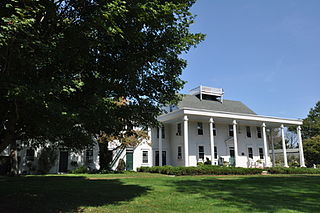
Hopelands is a historic country estate on Wampanoag Road in Warwick, Rhode Island. It is now the campus of the Rocky Hill School, a private college preparatory school. The historic centerpiece of the estate is a Colonial Revival mansion house, whose western ell is a wood-frame structure built in 1686. This house and its associated 75-acre (30 ha) property became the center of one of Warwick's first country estates, when in 1793 a Federal-style house was built by Thomas P. Ives and Hope (Brown) Ives, to which the old building was attached. This was given extensive Colonial Revival treatment in 1885 by Moses Goddard. The estate was acquired by the Rocky Hill School in 1948.
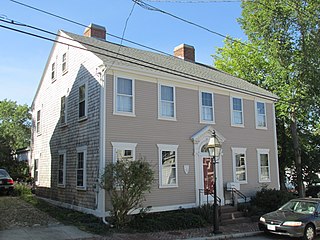
The Christopher Rhodes House is an historic house at 25 Post Road in the Pawtuxet village of Warwick, Rhode Island. The 2-1/2 story timber frame house was built c. 1800 by Christopher Rhodes, a prominent local businessman and cofounder with his brothers of the Pawtuxet Bank. The house was probably one of the finest Federal style homes of its time in the village, and is now one of the few to survive from that time. It has a side-gable roof, and is five bays wide with a center entry. The entry is topped by a fanlight and moulded architrave, and framed by Ionic pilasters.

The John R. Waterman House is an historic house at 100 Old Homestead Road in Warwick, Rhode Island. The 2-1/2 story wood frame house was built c. 1800 by John R. Waterman, a prominent local farmer and politician. Waterman played a significant role in what became known as Dorr's Rebellion, an ultimately successful attempt to force liberalizing changes to the state constitution. The house is an excellent local example of Federal style, and is locally distinct for its use of paired interior chimneys instead of a large central one.

The Moses Taft House is a historic house at 111 East Wallum Lake Road in Burrillville, Rhode Island. The 1 1⁄2-story side-gable Cape style house was built in 1786, and is a well-preserved example of early Federal architecture. It exhibits the typical five-bay facade, with the entry in the center bay, and a large central chimney. The house underwent a major restoration in the 2000s. Moses Taft, an early owner of the house, was a farmer and operated a nearby grist mill on the Clear River, with Seth Ross, who resided on Eagle Peak Road.

























